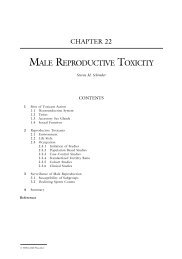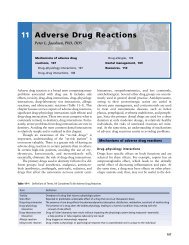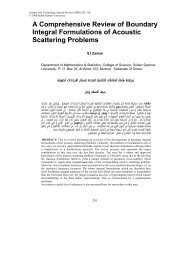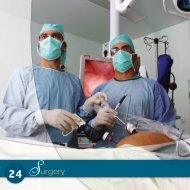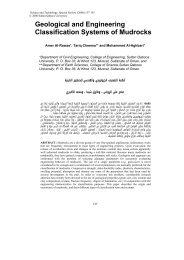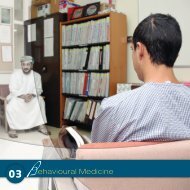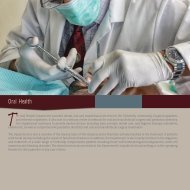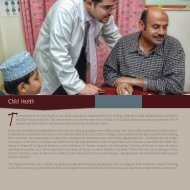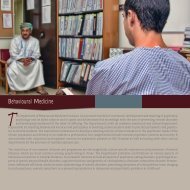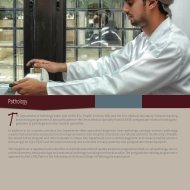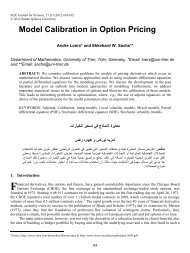<strong>Neonatal</strong> <strong>Hypotonia</strong> / 529or loss of hair on the occiput) may provide corroborativeevidence of longstanding hypotonia.Passive ManipulationProvided there is no limitation of joint movement (eg,arthrogryposis), flexor tone in the limbs may be evaluatedby observation of the power of recoil after rapid release ofan extended limb. Tone in the trunk and neck is assessedby observation of head and neck control during tractionmaneuvers, horizontal (prone) suspension, and verticalsuspension. The traction response, present by 33 weeks ofgestation, is the most sensitive measure. Thus, at term,when the infant is pulled by the arms from a supine to asitting position, the head should remain aligned with thebody (“absent head lag”) and the infant should respond tothe traction by flexion at the elbows, knees, and ankles. By40 weeks of gestation, when the infant is supported in aprone position with the examiner’s hands under the infant(ie, “horizontal suspension”), extensor tone in the neckmuscles should permit lifting of the head to maintain theneck and trunk in alignment for brief periods. During verticalsuspension when the infant is lifted up by the axillaewith the examiner’s hands around the thorax, the shouldermuscles should be strong enough to permit suspensionof the infant vertically with the head held erect and flexionat the hips, knees, and ankles. In hypotonic infants, thehead typically falls forward and the legs dangle and theinfant has a tendency to “slip through” the hands of theexaminer. Both spasticity (ie, velocity-dependent increasein resistance during passive limb movement) and rigidity(ie, constant increased resistance to passive manipulationthroughout the range of movement) may be tested in newbornsin a fashion similar to that used in older individuals.Examination of resistance of the hips to passive abductionis an important test for spasticity in the lowerextremities (eg, spastic diplegia), a common pattern ofabnormal tone in infants born prematurely.Some investigators have described specific maneuversfor the passive manipulation of limbs in the neonate (eg,approximation of heel to ear, hand to opposite ear “scarfsign,” and measurement of popliteal angle) in an attemptto quantify the maturation of muscle tone.Tendon Reflexes and Plantar ResponseThe formal examination of tendon reflexes in the newbornmay be of limited value because the range of normalityis difficult to define. Thus, there may be markedvariability in the briskness of reflexes from one occasion toanother in the same infant. Reflexes tend to be less activein premature infants. Reflexes in the lower limbs, especiallythe patellar reflexes, typically appear more brisk andare easier to elicit than those in the upper extremities. Theknee jerks may be accompanied by crossed adductorresponses, which, unless pronounced, should not necessarilybe considered abnormal until after 6 to 8 months ofage. Similarly, up to five to ten beats of ankle clonus maybe considered normal, especially in infants who are crying,hungry, or jittery and in whom there are no other signs ofupper motor neuron dysfunction.Classically, the plantar response in the newborn hasbeen considered to be extensor. However, there is considerablevariation in this response depending on the techniqueused because of several competing reflexes that areinvolved. For example, a mild stimulus (eg, dragging thethumbnail along the lateral aspect of the sole of the foot)results in flexion of the toes in more than 90% of infants,whereas a more painful stimulus generally results in anextensor response. Thus, the plantar response should beconsidered to be of limited value for determining the presenceof an upper motor neuron lesion in the newborn.Muscle Power and MovementThe quantity, quality, and symmetry of both spontaneousand elicited movements are of major importance in the evaluationof central nervous system (CNS) function in pretermand term infants. In premature infants, movements of thetrunk and limbs often have a slow, asymmetric, twisting andstretching quality that may resemble athetoid movements.In addition, there may be rapid, jerky, wide-amplitude limbmovements that resemble myoclonus. By 32 weeks of gestation,movements are predominantly flexor, often occurringsymmetrically. By term, infants are particularly active,with smooth, alternating limb movements of medium speedand intensity in response to gentle stimulation.Normal movement patterns in the newborn are characterizedby their overall variability. Consequently, repetitive,stereotypical movements (eg, bicycling of the legs and rowingof the arms) should raise suspicion of neurologicabnormality (eg, seizure). <strong>Hypotonia</strong> is often accompaniedby an overall decrease in spontaneous and elicited movements.Increased frequency of movements may be associatedwith cerebral irritability. Movements that are consistentlyasymmetric may be a sign of focal brain injury orbrachial plexus injury. Jitteriness, which involves markedstimulus-sensitive tremulousness of the limbs that may beinhibited by changing the limb position, may be normal, orit may occur in the context of neurologic dysfunction (eg,hypoxic-ischemic encephalopathy and drug intoxication).Sensory ExaminationCareful sensory examination is important in the contextof hypotonia and should not be limited to eliciting a with-Current Management in Child Neurology, Third Edition© 2005 Bernard L. Maria, All Rights Reserved <strong>Neonatal</strong> <strong>Hypotonia</strong>BC Decker Inc Pages 528–534
530 / The Hospitalized Childdrawal response only. Premature newborns of greater than28 weeks’ gestation are capable of discriminating betweentouch and pain. The rooting reflex, elicited by gentle touchof the perioral region, is established by 32 weeks of gestation.A more accurate approach to the testing of sensoryfunction involves observing the infant’s response to multiple(five) sharp stimuli (eg, pin pricks) to the medialaspect of the extremities, which should elicit a purposefulavoidance maneuver (lateral withdrawal) as well as agrimace or cry after a recognizable brief latentperiod. Furthermore, this response should “habituate” ordecrease with repeated testing. A stereotypical responseand lack of habituation generally indicates considerablecerebral dysfunction. Sensory examination, especially ofthe lower limbs, may be crucial for diagnosing a spinallesion as a cause of hypotonia by determining a definitesensory level.Developmental or Primary<strong>Neonatal</strong> ReflexesThese reflexes represent complex, stereotyped, and patternedresponses of the immature nervous system, theunderlying specific anatomic and physiologic mechanismsof which are largely undefined. Developmental reflexesmay be classified further as postural reflexes (eg, Mororeflex, asymmetric tonic neck reflex), or tactile reflexes (eg,sucking-swallowing and rooting reflexes, grasp reflex, placingand stepping, and trunk incurvation [Galant reflex]).The maturation of the most common developmentalreflexes is outlined in Table 81-2. Clinical abnormalities ofthese reflexes may be classified as (1) lack of an expectedresponse, (2) an asymmetric response, and (3) persistenceof a reflex beyond the expected age of disappearance.Approach to DiagnosisThe major task in the evaluation of a hypotonic newbornis to determine the anatomic level of the underlying pathology(ie, does the hypotonia reflect an abnormality withinthe central or in the peripheral nervous system). Mosthypotonic infants may be categorized on the basis of a carefulhistory and physical examination alone. The major clinicalfeatures that distinguish between cerebral and peripheralhypotonia are summarized in Table 81-3.Clinical Features of Central <strong>Hypotonia</strong>Other evidence of abnormal brain function (eg, abnormallevel of consciousness or seizures) is the strongest clue thathypotonia is of central origin. There may be dysmorphicfeatures or malformations of other organs that suggest anunderlying genetic abnormality. When hypotonia is of centralorigin, the degree of muscle weakness is usually mild,the tendon reflexes are normal or hyperactive, and there isno evidence of muscle fasciculations. Tight fisting of thehands, which do not open spontaneously and in which thethumbs are enclosed by the other fingers or adductedacross the palmar surface (palmar thumbs), is a sign ofcerebral dysfunction. Adduction of the thighs such thatthe legs are crossed when the infant is held in vertical suspension(scissoring) may be evidence of lower limb spasticity.Postural reflexes are generally preserved in infantswith cerebral hypotonia despite a paucity of spontaneousmovements. In fact, in some acute encephalopathies, theMoro reflex may be exaggerated. With extensive hemisphericabnormality but preserved brainstem function, thetonic neck reflex may be “obligatory,” (ie, the posture ismaintained for as long as the head is rotated). Becausehypotonia is a common feature in central disorders in thenewborn, a wide range of investigations may need to beconsidered to establish a precise, underlying diagnosis.Clinical Features ofPeripheral <strong>Hypotonia</strong>In general, disorders of the motor unit are not associatedwith malformations of other organs, except deformities ofbones or joints (arthrogryposis). Muscle weakness is usuallymore marked, and there may be atrophy. Tendonreflexes are usually diminished or absent. Fasciculations,often observed in the tongue, suggest denervation, but areoften very difficult to distinguish from normal randomtongue movements. Postural reflexes are absent or diminishedand limbs that lack voluntary movement also cannotmove reflexively.TABLE 81-2.Maturation of Developmental ReflexesReflex Age at Emergence Age at Disappearance (months)Moro reflex 27 weeks (incomplete) 6Asymmetric tonic neck response 35 weeks 6Sucking and rooting 2nd trimester 4Grasp 27 weeks 2Placing and stepping 34–37 weeks 1–2Trunk incurvation (Galant reflex) 24 weeks 12Current Management in Child Neurology, Third Edition© 2005 Bernard L. Maria, All Rights Reserved <strong>Neonatal</strong> <strong>Hypotonia</strong>BC Decker Inc Pages 528–534





